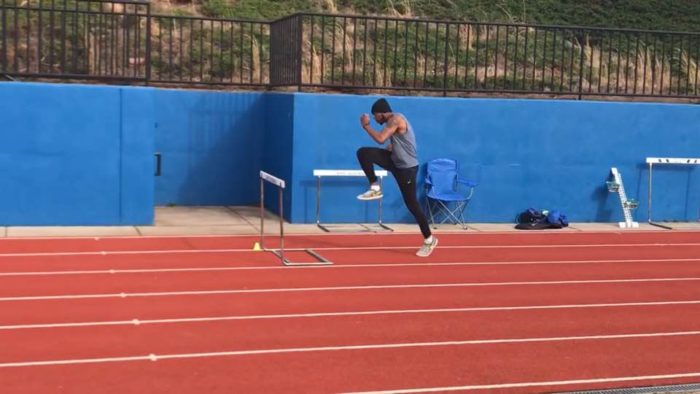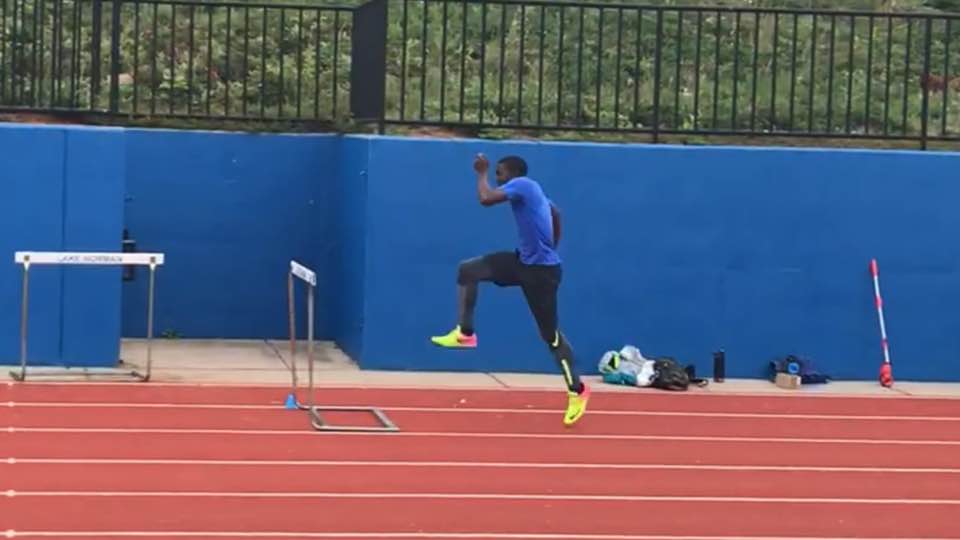I Said, Lead with the Knee!
by Steve McGill
Perhaps the most basic of all hurdle instructions, that I would think every hurdle coach would agree on, is that it’s best to lead with the knee of the lead leg when attacking each obstacle, as opposed to swinging the leg as one piece from the hip. However, what I’ve come to realize over the years is that “lead with the knee” means different things to different people. Also, there are degrees of leading with the knee, meaning that not all leadings with the knee are equally pronounced and equally observable. In this article, I will discuss what I mean when I instruct my hurdlers to lead with the knee. You will notice as you read that my approach to teaching it has as much to do with what the heel does as with what the knee itself does.
[am4show not_have=’g5;’]
[/am4show][am4guest]
[/am4guest][am4show have=’g5;’]
The mistake that I often see is that of driving the foot forward before the knee reaches full height. A lot of hurdlers fake themselves out. Just because the knee is bent, as opposed to straight-legged, doesn’t mean that you’re leading with the knee. Your knee can be bent with the foot leading the way.
Last week I was on Instagram scrolling when I came across a clip of a hurdler I follow in which she was performing some pretty simple drills. She looked good doing them, but something seemed off. Resisting the urge to continue scrolling, I looked more closely, and noticed that she was higher over the hurdles than she needed to be; her hips were rising. Why were her hips rising? That was an easy one: her foot was extending forward too soon.
The basic rule is, the knee should be higher than the height of the crossbar before the foot starts to extend toward the hurdle. If the foot gets ahead of the knee before the knee is higher than the bar, then you’re leading with the foot, not with the knee. Leading with the foot forcesyou now to kick the foot up, whereas leading with the knee allows you to kick the foot forward or slightly downward (males over 39’s or 42’s) or downward (females) so that you can sprint off the hurdle fluidly, on balance, with no adjustments or shifts in weight needed to be made upon landing. When you lead with the foot, you create a ripple effect of flaws. The foot will swing up instead of forward or downward, because it has to swing up to give you the height you need to clear the hurdle. Now, your foot, not your knee, is giving you the height you need, making the hurdle feel higher than it actually is. Also, once that foot starts kicking up, you have no control over it. It’s going to cause you to float whether you like it or not. I always tell my hurdlers, “Your knee is your steering wheel.” It’s what keeps you moving in a straight line, with low clearance. Now, with the foot kicking out, your hips have no choice but to rise vertically when you take off, which is what causes increased air time and the feeling of floating over the hurdle. When leading with the knee, the hips can push forward and help you to continue accelerating.
The floating will usually cause twisting—in the hips and shoulders, which will lead to the arms trying to compensate by moving in a side-to-side action instead of staying up and down. And of course, the trail leg will end up flattening out (at worst). At the very least, even if you’re able to keep the trail leg knee high, it will not be able to face the front by the time the lead leg lands.
So yeah, not leading with the knee can make you look like a mess. How to fix it? Focus on what the heel is doing. The heel? Yeah, the heel. Check it out:
The above photo shows a hurdler who is legit leading with the knee. Notice where the heel of his lead leg is when he is taking off. It is under his hamstring. Upon leaving the ground, it came directly up under his hamstring. When the heel comes up, not out, you are in position where you can truly lead with the knee. So, the knee and the toe are in a direct vertical line, but the heel is behind the knee, under the hamstring. If the heel is in front of the knee during take-off, or even parallel to it, that foot is going to swing out and up, causing the other issues mentioned above.
The above photo shows a hurdler who is kinda-sorta leading with the knee, but not really. Why? Because the heel is getting ahead of the knee too soon. Instead of being tucked under the hamstring, it’s already moving forward, toward the hurdle. It is also too low
What causes the problem of leading with the foot instead of the knee? A number of factors could be the culprit: flaws in sprint mechanics, low-key fear of the obstacles, weak hip flexors, and anticipating the hurdle instead of running through the hurdle (for hurdlers who do have good sprint mechanics) are among the main culprits.
When looking to correct the issue, or any technique issue, the first option is always to go back to the athlete’s sprint mechanics. In this case, does the athlete have back-kick in his or her stride? If so, that would explain why the heel gets ahead of the knee too soon. Back-kick sets up a swinging-to-the-front motion. So, if back-kick is the cause, you won’t fix the problem until you fix the back-kick. The way to do that is to go back to the roots—A marches, A skips, sprinting wall drills, teaching the athlete to keep the ankles dorsi-flexed, to land on the ball of the foot. It’s tedious, but it’s worth it. Don’t let the athlete do a single stride of a drill incorrectly without pointing it out.
Side walk-overs for lead leg are also good for teaching dorsi-flexion and leading with the knee. Start with very low hurdles and work your way up gradually.
Weak hip flexors force the athlete to rely more on the hamstrings when running over hurdles, leading to hamstring strains and tears. And because everything is connected, hurdlers with a lot of hamstring problems on the lead leg side often have a lot of groin problems on the trail leg side. Without strong hip flexors, you might not be able to get the knee up high enough during take-off no matter how hard you try. So, there are machines at most gyms that are designed to help strengthen the hip flexors. Also, doing hip exercises with bands attached to the feet can serve the same purpose. I’m old school, so I also like hip exercises with ankle weights attached to the feet.
The overall message of this article is, don’t settle for kinda-sorta leading with the knee. While it is possible to compensate with speed and power, you don’t want to be in a position where you’re compensating all the way down the track. A truly aggressive knee-first action will minimize other technical flaws (and perhaps even correct some), and it will make you faster between the hurdles, with less effort.
[/am4show]


